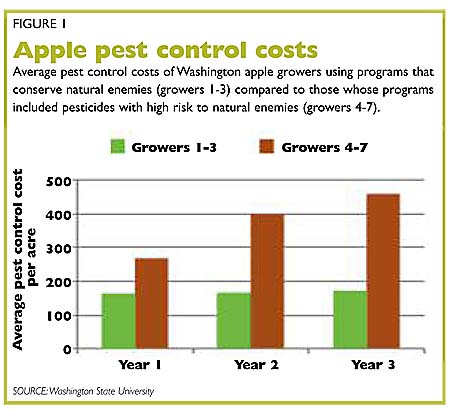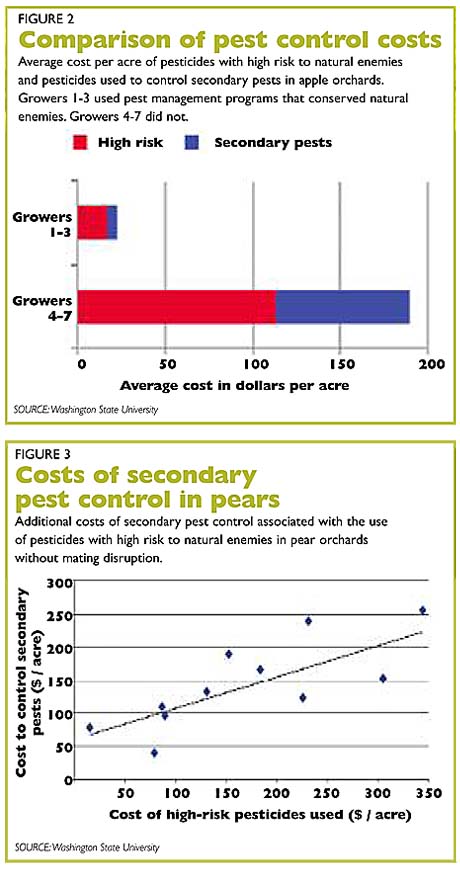Washington State University entomologist Dr. Stan Hoyt developed integrated mite control in the late 1960s (see “How integrated mite control works”).
Over the last four decades, integrated mite control has saved Washington fruit growers millions of dollars each year because they did not have to use specific miticides to control spider mites.

National surveys of pesticide use in apples show that, over the last 20 years, an average of 24 percent of the Washington acres were treated annually with miticides. By comparison, 76 percent of Michigan and 70 percent of New York apple acres, on average, were treated annually with miticides.
Washington apple growers have also benefited from biological control of the western tentiform leafminer and the white apple leafhopper. These natural enemies are somewhat unique because they have developed a tolerance to certain organophosphate insecticides.
Apple and pear orchards have changed as regulatory actions have phased out or restricted the use of many organophosphate insecticides. Alternative insecticides have taken their place, and we are only just beginning to understand their impact on natural enemies. Our project looked at the impact of several organophosphate-alternative insecticides plus some fungicides on eight natural enemies. Results showed that the reduced-risk attributes of these organophosphate alternatives apply to humans but not necessarily to natural enemies.
To better understand the economic value of biological control in apple and pear orchards, we analyzed pest control records from several growers over three years. We calculated both the cost of each pesticide and the application cost. We identified the target(s) for each pesticide and rated its risk (low, medium, or high) to natural enemies. By taking this approach, we could measure the disruptive effect on natural enemies of different pest control programs by the need to apply controls for secondary pests (aphids and spider mites in apple, and spider mites and summer pear psylla in pear).
Apples
For apples in Washington, we analyzed pesticide use information from seven growers over three years, 2007 to 2009. The average cost of insect and mite pest control over all years was $286, plus or minus $39 per acre, with an average of nine pesticides being applied. We examined the relationship between the use of pesticides with high risk to natural enemies and pesticides used to control secondary pests. We found that for every $1 spent on a high-risk pesticide, it cost an extra $0.52 to control secondary pests. Three of the seven growers (growers 1-3) had transitioned away from organophosphate insecticides and had a stable integrated pest management program relying on pheromones and low-risk organophosphate alternatives. Their average pest control program cost over three years was $166 per acre, with little change over time (Figure 1). These growers had an average cost of $5 per acre for secondary pest control and used no high-risk pesticides in years two and three (Figure 2). The average pest control program cost for the other four growers, growers 4-7, was $377 per acre, but their costs increased over three years (Figure 1). These growers had an average cost of $113 per acre for high-risk pesticides and another $77 per acre for secondary pest control (Figure 2). These examples demonstrate that there are added costs associated with pest control programs that do not follow practices that conserve natural enemies in apple orchards.
Pears
For pears produced in Hood River, Oregon, we analyzed pesticide use information from nine growers over the three years, 2008 to 2010. Five of these growers used pheromones for codling moth control while four did not. The average pest control cost in Oregon pears was $650, plus or minus $20 per acre, or $365 per acre more than in Washington apples. Growers using pheromones had slightly higher costs per acre ($666) than growers not using pheromones ($631). On average, growers using mating disruption spent $26 more on scale, and $6 more on leafroller control, but $59 per acre less on pear psylla and mites. However, for growers not using pheromones, every $1 spent on a high-risk pesticide cost an extra $0.47 to control secondary pests (Figure 3). This suggests there is value to be captured in pear IPM programs through the conservation of natural enemies.
Pheromones
While there was some benefit in terms of pear psylla control of using pheromones for codling moth control, this tactic did not result in a cost saving for control of secondary pests that completely offset the cost of the pheromone. However, similar to what was observed in apple, some pear growers that used mating disruption also continued to apply insecticides for codling moth that are of moderate to high risk to natural enemies. Despite the disruptive impacts of some of these sprays, growers using pheromones typically applied one less spray for pear psylla during the summer, indicating that natural enemies were likely contributing to pear psylla management. There is evidence that this is happening in other pear orchards in Hood River, where growers who switched to use of pheromones are reporting fewer problems with pear psylla. The role of natural enemies in these orchards needs further documentation, but if biological control is contributing to pear psylla control, then this could open up a new era in pear pest management.
The cost of pest management is not the only important factor in establishing the value of biological control. If natural enemies can reduce pesticide use, then other aspects such as restricted entry intervals, preharvest intervals, and maximum residue limits may be less of a concern. In our apple examples, the three growers with programs that conserved natural enemies also applied the last insecticide of the season well before harvest. Those pest control programs that showed disruption of secondary pests tended to apply the last insecticide in late July or early August, on average about 60 days later than programs that conserved natural enemies.
The economic analyses of apple and pear pest management costs presented here illustrate several benefits for integrating biological control into orchard pest management programs. Apples have a long and successful history with integrated mite control that has resulted in huge economic savings. In contrast, for pear, implementing stable pest management programs that integrate biological control continues to be more challenging.
This is the fifth article in an eight-part series highlighting results of a five-year Specialty Crop Research Initiative project to enhance biological control of orchard pests. The project involves researchers from Washington State University, Oregon State University, University of California Berkeley, and the U.S. Department of Agriculture in Yakima, Washington.

Leave A Comment